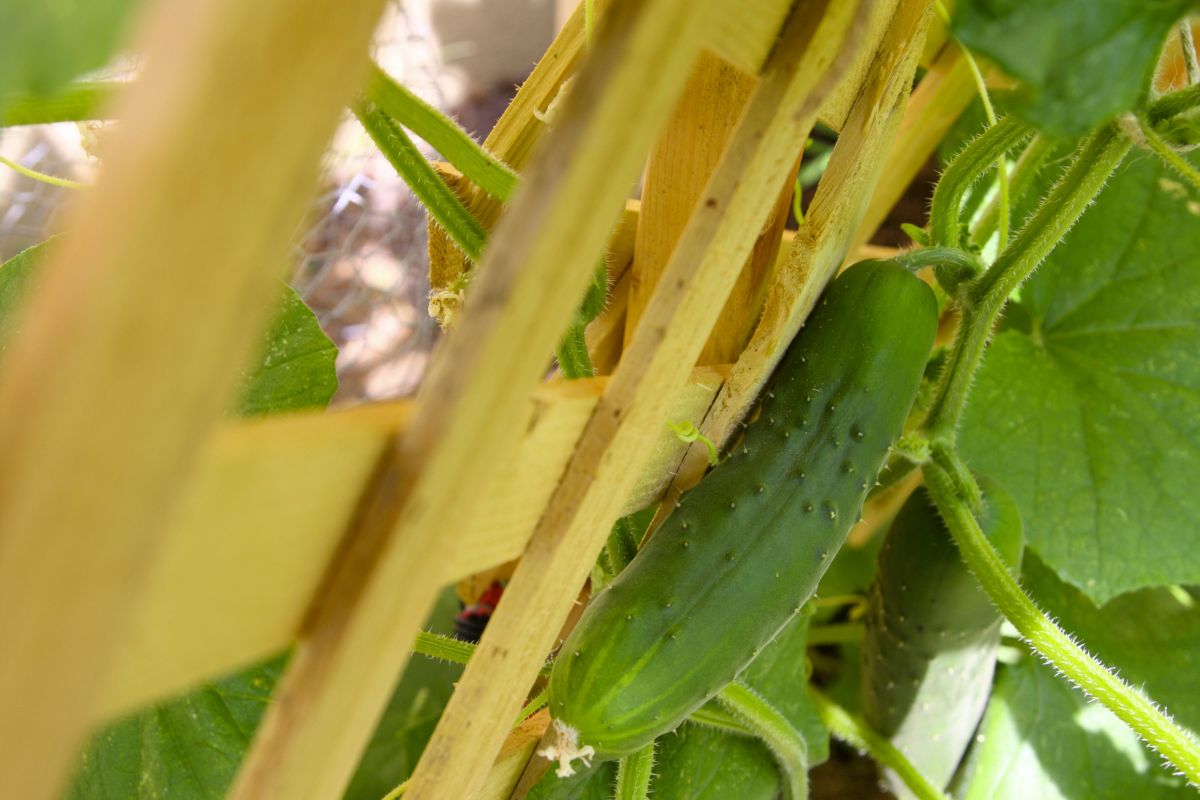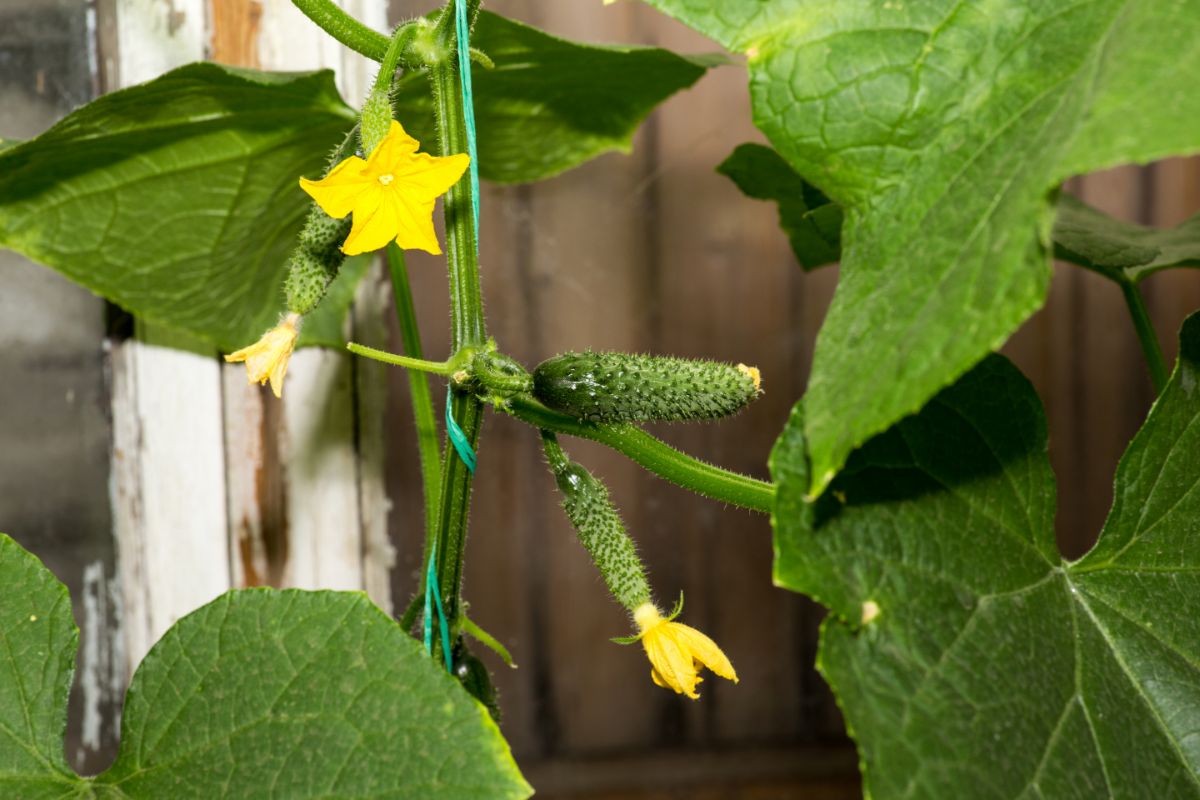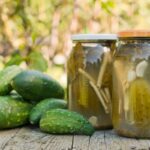A lush, sun-dappled garden brimming with verdant vines of cucumbers can be a sight of true delight for any gardening enthusiast.
Not only are cucumbers versatile and delicious, but their cultivation on a trellis also offers a novel, efficient and space-saving approach to garden management.

In this guide, I will share the finer nuances of growing cucumbers on a trellis, thereby transforming your green fingers into seasoned, cucumber-growing hands.
Why Grow Cucumbers On Trellis?
Before we get into the ‘how’, it’s first worth understanding the why.
I’d never grown my cucumbers on a trellis until a few years ago, I’d always opted for pots, so I was pretty sceptical, but it’s actually a great growing method.
Trellising your cucumber plants can provide several key benefits, not least of which is maximising space in smaller gardens.
A trellis allows the plant to grow vertically rather than spreading out on the ground. This upward growth also leads to healthier plants as they receive better air circulation, thus minimising the risk of soil-borne diseases.
Additionally, cucumber fruits grown on a trellis are easier to spot and harvest. They often exhibit more uniform shapes, cleaner skin, and less susceptibility to damage or rot from sitting on damp soil. With these compelling reasons in mind, let’s delve into the step-by-step process.
How To Grow Your Cucumbers On A Trellis
There are a few things to consider if you want to grow cucumbers on trellis, let’s explore them together:
Choosing Your Cucumbers
There are a plethora of cucumber varieties to choose from, but for trellising, vining cucumbers are your best bet.
Unlike bush cucumbers, which are better suited to ground growth, vining varieties flourish with vertical support, producing tendrils that help the plant cling to the trellis.
Favourites among gardeners include the ‘Marketmore 76’, ‘Straight Eight’, and the burpless variety ‘Suyo Long’.
Trellis Types And Construction
There’s no one-size-fits-all when it comes to trellis designs. You can use a myriad of materials, from wooden stakes and lattice to metal rods and netting.
The key is to ensure the structure is sturdy enough to support the weight of your maturing cucumber plants and their fruits. Your trellis should also be high enough to let the cucumbers grow and hang freely. A height of 5 to 6 feet is generally adequate.
The A-frame or lean-to designs can provide excellent support and easy access to plants. Alternatively, a simple vertical grid or fence-style trellis can be equally effective.
Keep in mind that the gaps within your trellis structure should allow your hand to pass through easily for hassle-free harvesting.
Planting Your Cucumbers
When it comes to planting cucumbers, timing and conditions are paramount.
Sow the seeds indoors in late spring, or directly outdoors when the soil temperature consistently hits 15°C (60°F). Cucumbers prefer a sunny spot and well-draining soil enriched with organic matter.
Plant the seeds about an inch deep, in rows set one foot apart. If you’re using a trellis, plant the seeds at the base of the structure.
Cultivating Your Soil
Healthy soil is the cornerstone of a thriving garden, and cucumbers are no exception. Cucumbers favour a soil pH of 6.0 to 7.0. You can check your soil pH using a soil testing kit available at most garden centres.
If your soil is on the acidic side, consider adding lime to increase pH. For alkaline soils, adding sulphur can help to lower the pH.
To ready your garden for planting, break up the soil using a garden fork or tiller. This aerates the soil, making it easier for cucumber roots to penetrate.
Next, mix in organic matter such as compost or well-rotted manure. Organic matter not only feeds your plants but also improves soil structure and water-holding capacity.
Companion Planting
Companion planting can be a valuable tool in your gardening arsenal. Some plants have complementary growing habits or exude substances that can benefit their neighbours.
For cucumbers, good companions include beans, corn, and peas, which add nitrogen to the soil. Marigolds, nasturtiums, and radishes can help deter cucumber beetles and other pests.
However, avoid planting cucumbers near potatoes and aromatic herbs like sage and rosemary, as these can inhibit cucumber growth.

Training And Pruning
As the cucumber vines start to grow, gently guide them towards the trellis, encouraging the tendrils to grasp onto the support. With time, the plants will naturally ascend, but a bit of guidance can be helpful, especially in the early stages.
Pruning is another key aspect. It enhances the plant’s health, improves fruit quality, and allows better sunlight penetration. Prune the lower leaves once the plant starts flowering.
As the vine grows, remove any lateral shoots beyond the 5th to 6th leaf node to focus the plant’s energy on the main vine and fruit production.
Watering And Feeding
Cucumbers are thirsty plants, so regular watering is critical. Water deeply at the base of the plants, ideally in the morning, to allow excess moisture to evaporate throughout the day. It’s best to water the soil, not the leaves, to help prevent mildew and other diseases.
A balanced, all-purpose fertiliser applied every two weeks can provide the nutrients cucumbers need to flourish. Compost or well-rotted manure can also enrich the soil and boost productivity.
Pest and Disease Management
Cucumbers can be susceptible to a few pests and diseases. Common culprits include cucumber beetles, aphids, powdery mildew, and bacterial wilt.
To keep pests at bay, consider using floating row covers until the plants start to flower. As for diseases, rotating your crops each year can help break disease cycles.
Should you spot signs of disease, like white powdery spots (powdery mildew) or wilting leaves (bacterial wilt), act promptly. Organic fungicides can treat mildew while removing and destroying infected plants can halt the spread of bacterial wilt.
Remember, healthy plants are less likely to succumb to pests and diseases, so maintain good cultural practices. This includes proper spacing, regular watering, and adequate nutrition.
Extending Your Growing Season
In colder climates, the cucumber growing season can be short. Luckily, there are several strategies to extend it.
Start seeds indoors around 4-6 weeks before the last expected frost. Then, transplant the seedlings outdoors once the soil warms up.
Using black plastic mulch can also help to warm the soil earlier in spring. Not only does it trap heat, but it also suppresses weeds and keeps the soil moist.
For a late-season crop, plant a second round of cucumbers in mid-summer. Choose a fast-maturing variety to ensure you can harvest before the first autumn frosts arrive.
Harvesting
The moment of truth! Harvest time depends on the cucumber variety, but generally, cucumbers are ready when they’re firm and bright green. Overripe cucumbers may turn yellow and contain hard seeds.
Harvest often, as this encourages more fruit production. Use a sharp knife or pruners to cut the fruit from the vine without damaging it.
Did you know – cucumbers don’t always grow in the intended shape – this could be because there has been a mutation or it might be because of the growing conditions.
Final Thoughts
In conclusion, growing cucumbers on a trellis can be an efficient, rewarding, and aesthetically pleasing gardening endeavour. While it might require a bit of a learning curve, the benefits far outweigh the challenges.
So, why not give trellis-grown cucumbers a try? With these tips and a bit of patience, you’ll be well on your way to growing beautiful, bountiful cucumbers high on the vine.
- Can You Grow Bell Peppers Indoors? A Guide For New Gardeners - November 14, 2023
- Composting Basics: Can You Compost Mushrooms? - November 6, 2023
- A Gardener’s Guide To Growing Carrots In Raised Beds - November 1, 2023






